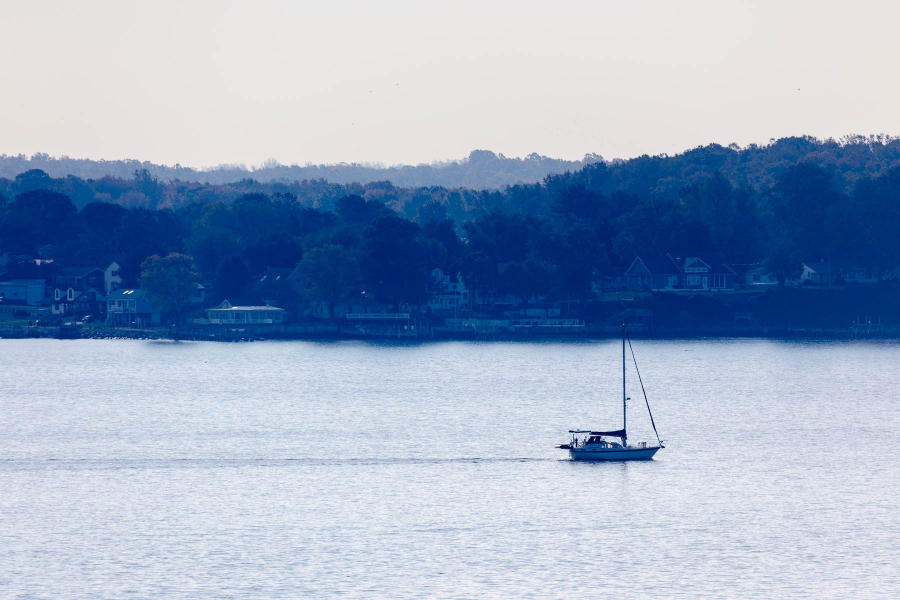Chesapeake Bay receives highest health grade in over 20 years
Bay receives a C+ in annual University of Maryland Center for Environmental Science report card

The mood at the Susquehanna River Basin Commission in Harrisburg, Pennsylvania was joyous, despite the excessive heat warning that kept attendees inside the building. Bill Dennison, vice-president for science application at the University of Maryland Center for Environmental Science (UMCES)’s Integration and Application Network proudly told the assembled crowd, which included environmental and agricultural secretaries from both Maryland and Pennsylvania, the Environmental Protection Agency’s Mid-Atlantic Regional Administrator and even the Governor of Pennsylvania, “we are starting to see the results of a lot of hard work.”
The results he was speaking of is a C+ on UMCES’ annual Chesapeake Bay Report Card–the highest grade the Bay has received since 2002. The report card reflects the status of the Bay in 2023, marking a 4% increase from the previous year’s assessment and an overall significantly improving trend from 1986-2023.
The report card looks at 11 different indicators to determine the health of the Bay. They include dissolved oxygen, nitrogen, phosphorus, chlorophyll a, water clarity, underwater grasses, benthic communities, stewardship, walkability, heat vulnerability and fish communities. The indicator with the highest score was dissolved oxygen, as the Chesapeake Bay marked the smallest dead zone on record in 2023. This was followed by significant improvements in phosphorus, with the lower Bay receiving a perfect score.
The grade was negatively impacted by the acreage of underwater grasses, chlorophyll a and water clarity. Underwater grasses continue to rebound after heavy rains in 2018-2019, with the mid-Bay still showing heavy losses. Chlorophyll a, a measure of the amount of algae growing in the water, is used to determine the level of biological activity (the presence of fish, plants, insects and other organisms) within the Bay. The highest concentrations of chlorophyll a in 2023 occurred in the Back, Patapsco and Patuxent rivers, the upper Bay and in some locations in the lower Bay. Water clarity measures how far down light can penetrate through the water. Low water clarity prevents the growth of underwater grasses, leading to a decline in plants and animals. The report card found overall water clarity in the entire Bay to be poor, with the mid-Bay having the clearest water.

In addition to assessing the Bay proper, the report card also looks at the overall health for the watershed. The Chesapeake Bay watershed was graded a C, remaining the same as the previous year. The overall watershed grade is determined by the same 11 indicators for the Bay, but also includes societal and economic indicators, such as median income and job growth. The societal and economic indicators are not updated every year as the ecological indicators are, but rather when data updates are available.
The most notable improvements for the watershed health grade was the decline in nitrogen and phosphorus levels, which in turn raised the overall water quality index score. The upper James and lower Potomac regions had the highest water quality index score in the watershed.
The benthic community indicator negatively impacted the watershed score the most. The Choptank region along Maryland’s Eastern Shore, as well as parts of the Western Shore, were found to have the lowest levels of organisms living at the bottom of their rivers and streams. These organisms can include clams, worms, oysters and mussels and are extremely important to the overall food web of the ecosystem.
At the report card release, Dennison touted the investments made by the Commonwealth of Pennsylvania in helping to boost the score of the Susquehanna River, which is the largest tributary flowing into the Bay.
“The upper Chesapeake Bay, which receives the Susquehanna River, has the second highest score in Bay health, and it continues to improve,” Dennison said. “This improvement is a testament to efforts to reduce nutrients in the Susquehanna River watershed, underscoring the hard work in Pennsylvania on nutrient reduction and riparian buffers.”
Overall, 11 out of 15 regions of the watershed improved or remained steady from the previous year. The lower Bay received the highest score in the watershed with a B. The upper portion of the Chesapeake Bay, fed by the Susquehanna River, achieved a B- grade for the first time.
Pennsylvania Governor Josh Shapiro remarked, “Pennsylvania’s portion of the watershed is significantly improving because we’ve brought people together and invested in Chesapeake Bay restoration efforts.”
UMCES is now working on a man-made debris indicator for next year’s report card. It will help scientists better understand how debris such as microplastics and trash is impacting the Chesapeake Bay, and identify those regions in need of prevention and mitigation activities.
The full report card can be viewed at https://ecoreportcard.org/report-cards/chesapeake-bay/.

Comments
There are no comments.
Thank you!
Your comment has been received. Before it can be published, the comment will be reviewed by our team to ensure it adheres with our rules of engagement.
Back to recent stories